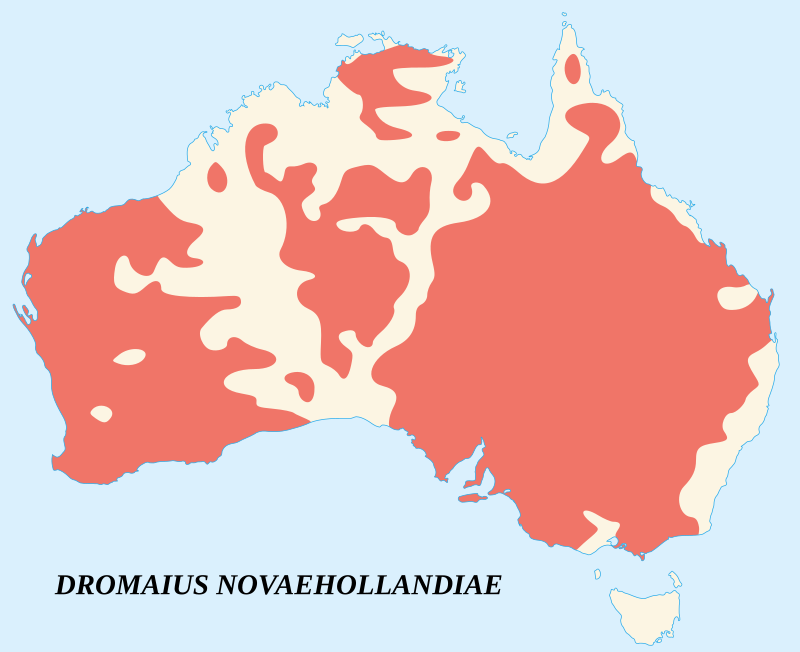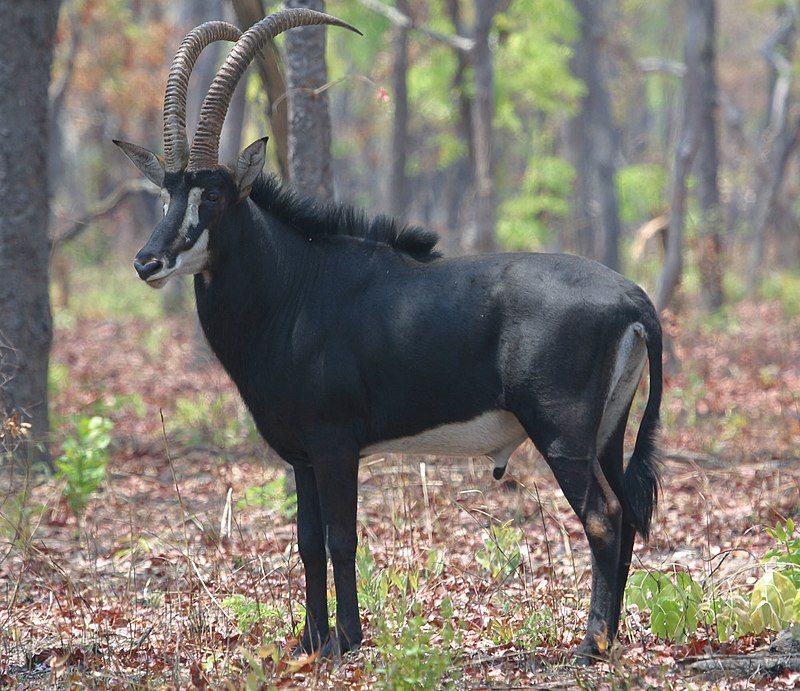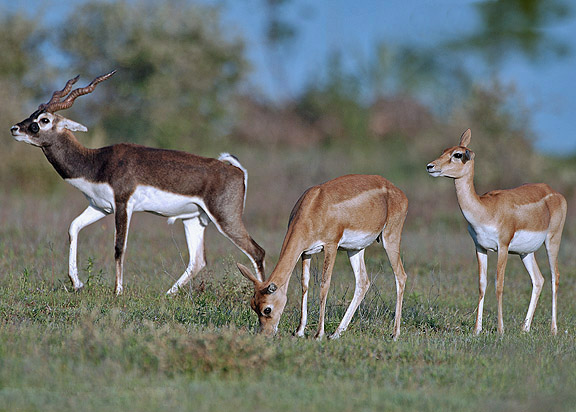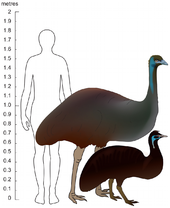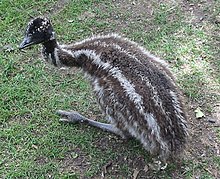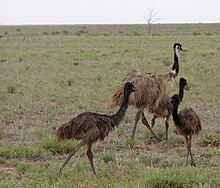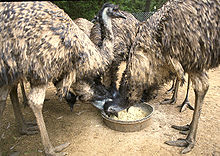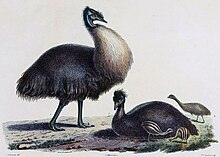The
emu (
Dromaius novaehollandiae) is the second-largest living bird by height, after its
ratite relative, the
ostrich. It is
endemic to Australia where it is the largest native bird and the only
extant member of the
genus Dromaius. The emu's range covers most of mainland Australia, but the
Tasmanian emu and
King Island emu subspecies became extinct after the
European settlement of Australia in 1788. The bird is sufficiently common for it to be rated as a
least-concern species by the
International Union for Conservation of Nature.
Emus are soft-feathered, brown,
flightless birds
with long necks and legs, and can reach up to 1.9 metres (6.2 ft) in
height. Emus can travel great distances, and when necessary can sprint
at 50 km/h (31 mph); they forage for a variety of plants and insects,
but have been known to go for weeks without eating. They drink
infrequently, but take in copious amounts of water when the opportunity
arises.
Breeding takes place in May and June, and fighting among females for a
mate is common. Females can mate several times and lay several clutches
of eggs in one season. The male does the incubation; during this
process he hardly eats or drinks and loses a significant amount of
weight. The eggs hatch after around eight weeks, and the young are
nurtured by their fathers. They reach full size after around six months,
but can remain as a family unit until the next breeding season. The emu
is an important cultural icon of Australia, appearing on the
coat of arms and various coins. The bird features prominently in
Indigenous Australian mythology.

Taxonomy
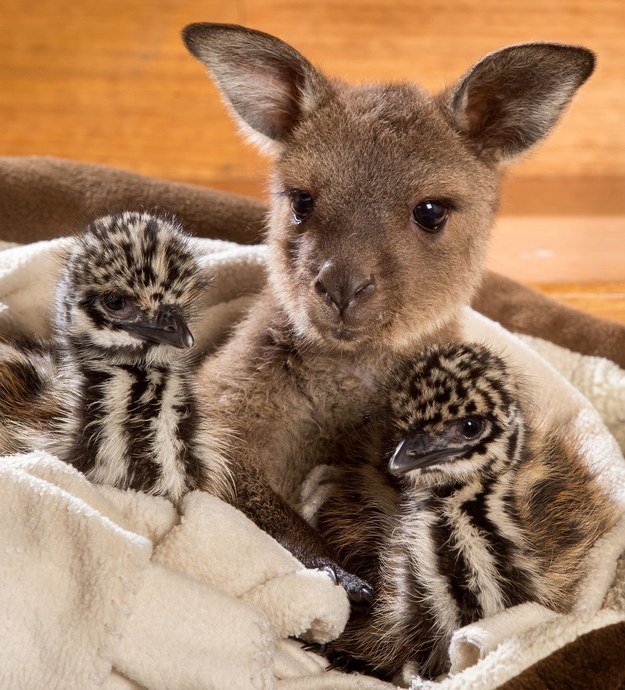
History

Emus were first reported as having been seen by Europeans when
explorers visited the western coast of Australia in 1696; this was an
expedition led by Dutch captain
Willem de Vlamingh who was searching for survivors of a ship that had gone missing two years earlier.
[6] The birds were known on the eastern coast before 1788, when the first Europeans settled there.
[7] The birds were first mentioned under the name of the "New Holland
cassowary" in
Arthur Phillip's
Voyage to Botany Bay, published in 1789 with the following description:
[8][9]
This is a species differing in many particulars from that generally
known, and is a much larger bird, standing higher on its legs and having
the neck longer than in the common one. Total length seven feet two
inches. The bill is not greatly different from that of the common
Cassowary; but the horny appendage, or helmet on top of the head, in
this species is totally wanting: the whole of the head and neck is also
covered with feathers, except the throat and fore part of the neck about
half way, which are not so well feathered as the rest; whereas in the
common Cassowary the head and neck are bare and carunculated as in the
turkey.
The plumage in general consists of a mixture of brown and grey, and
the feathers are somewhat curled or bent at the ends in the natural
state: the wings are so very short as to be totally useless for flight,
and indeed, are scarcely to be distinguished from the rest of the
plumage, were it not for their standing out a little. The long spines
which are seen in the wings of the common sort, are in this not
observable,—nor is there any appearance of a tail. The legs are stout,
formed much as in the Galeated Cassowary, with the addition of their
being jagged or sawed the whole of their length at the back part.
The species was named by ornithologist
John Latham in 1790 based on a specimen from the
Sydney area of Australia, a country which was known as
New Holland at the time.
[3][10] He collaborated on Phillip's book and provided the first descriptions of, and names for, many Australian bird species;
Dromaius comes from a Greek word meaning "racer" and
novaehollandiae is the Latin term for New Holland, so the name can be rendered as "fast-footed New Hollander".
[11] In his original 1816 description of the emu, the French ornithologist
Louis Jean Pierre Vieillot used two
generic names, first
Dromiceius and later
Dromaius.
[12]
It has been a point of contention ever since as to which name should be
used; the latter is more correctly formed, but the convention in
taxonomy is that the first name given to an organism stands, unless it is clearly a
typographical error.
[13] Most modern publications, including those of the Australian government,
[5] use
Dromaius, with
Dromiceius mentioned as an alternative spelling.
[5]
The
etymology
of the common name "emu" is uncertain, but is thought to have come from
an Arabic word for large bird that was later used by Portuguese
explorers to describe the related cassowary in Australia and
New Guinea.
[14]
Another theory is that it comes from the word "ema", which is used in
Portuguese to denote a large bird akin to an ostrich or crane.
[7][15] In Victoria, some terms for the emu were
Barrimal in the
Dja Dja Wurrung language,
myoure in
Gunai, and
courn in
Jardwadjali.
[16] The birds were known as
murawung or
birabayin to the local
Eora and
Darug inhabitants of the Sydney basin.
[17]
Systematics
Size comparison between a human, the mainland emu (centre), and the extinct King Island sub-species (right)
The emu was long classified, with its closest relatives the cassowaries, in the family
Casuariidae, part of the
ratite order Struthioniformes.
[18] However, an alternate classification was proposed in 2014 by Mitchell et al., based on analysis of
mitochondrial DNA. This splits off the Casuariidae into their own order, the
Casuariformes,
[19] and includes only the cassowaries in the family Casuariidae, placing the emus in their own family,
Dromaiidae. The
cladogram shown below is from their study.
[20]
Two different
Dromaius species were present in Australia at
the time of European settlement, and one additional species is known
from fossil remains. The
insular dwarf emus,
D. baudinianus and
D. n. minor, originally present on
Kangaroo Island and
King Island respectively, both became
extinct shortly after the arrival of Europeans.
[14][21] D. n. diemenensis, a subspecies known as the
Tasmanian emu, became extinct around 1865. However, the mainland sub-species,
D. n. novaehollandiae,
remains common. The population of these birds varies from decade to
decade, largely being dependent on rainfall; in 2009, it was estimated
that there were between 630,000 and 725,000 birds.
[22] Emus were introduced to
Maria Island
off Tasmania, and Kangaroo Island off the coast of South Australia,
during the 20th century. While the Maria Island population died out in
the mid-1990s, more birds have since been introduced, and attempts are
being made to breed a form similar to the Tasmanian emu.
[23] The Kangaroo Island birds have successfully established a breeding population.
[24]
In 1912, the Australian ornithologist
Gregory M. Mathews recognised three living subspecies of emu,
[25] D. n. novaehollandiae (Latham, 1790),
[26] D. n. woodwardi Mathews, 1912
[27] and
D. n. rothschildi Mathews, 1912.
[28] However, the
Handbook of the Birds of the World
argues that the last two of these subspecies are invalid; natural
variations in plumage colour and the nomadic nature of the species make
it likely that there is a single race in mainland Australia.
[29][30]
Examination of the DNA of the King Island emu shows this bird to be
closely related to the mainland emu and hence best treated as a
subspecies.
[21]

Description

The emu is the second largest bird in the world, only being exceeded in size by the ostrich;
[31]
the largest individuals can reach up to 150 to 190 cm (59 to 75 in) in
height. Measured from the bill to the tail, emus range in length from
139 to 164 cm (55 to 65 in), with males averaging 148.5 cm (58.5 in) and
females averaging 156.8 cm (61.7 in).
[32]
Emus weigh between 18 and 60 kg (40 and 132 lb), with an average of
31.5 and 37 kg (69 and 82 lb) in males and females, respectively.
[32] Females are usually slightly larger than males and are substantially wider across the rump.
[33]
Emus have three toes on each
foot in a
tridactyl arrangement, which is an adaptation for running and is seen in other birds, such as
bustards and
quails. The
ostrich has two toes on each foot.
Although flightless, emus have
vestigial wings, the
wing chord measuring around 20 cm (8 in), and each wing having a small claw at the tip.
[32] Emus flap their wings when running, perhaps as a means of stabilising themselves when moving fast.
[7] They have long necks and legs,
[33] and can run at speeds of 48 km/h (30 mph) due to their highly specialised
pelvic limb musculature.
[32] Their
feet have only three toes and a similarly reduced number of bones and associated foot muscles; emus are the only birds with
gastrocnemius muscles
in the back of the lower legs. The pelvic limb muscles of emus
contribute a similar proportion of the total body mass as do the flight
muscles of flying birds.
[34] When walking, the emu takes strides of about 100 cm (3.3 ft), but at full gallop, a stride can be as long as 275 cm (9 ft).
[35] Its legs are devoid of feathers and underneath its feet are thick, cushioned pads.
[35]
Like the cassowary, the emu has sharp claws on its toes which are its
major defensive attribute, and are used in combat to inflict wounds on
opponents by kicking.
[36] The toe and claw total 15 cm (6 in) in length.
[35] The bill is quite small, measuring 5.6 to 6.7 cm (2.2 to 2.6 in), and is soft, being adapted for grazing.
[32] Emus have good eyesight and hearing, which allows them to detect threats at some distance.
[37]
The neck of the emu is pale blue and shows through its sparse feathers.
[32] They have grey-brown plumage of shaggy appearance;
[14] the shafts and the tips of the
feathers are black. Solar radiation is absorbed by the tips, and the inner
plumage insulates the skin.
[38] This prevents the birds from overheating, allowing them to be active during the heat of the day.
[39] A unique feature of the emu feather is the double
rachis
emerging from a single shaft. Both of the rachis have the same length,
and the texture is variable; the area near the skin is rather furry, but
the more distant ends resemble grass.
[7] The sexes are similar in appearance,
[40] although the male's penis can become visible when he urinates and defecates.
[41] The plumage varies in colour due to environmental factors, giving the bird a natural
camouflage.
Feathers of emus in more arid areas with red soils have a rufous tint
while birds residing in damp conditions are generally darker in hue.
[33]
The juvenile plumage develops at about three months and is blackish
finely barred with brown, with the head and neck being especially dark.
The facial feathers gradually thin to expose the bluish skin. The adult
plumage has developed by about fifteen months.
[29]
The eyes of an emu are protected by
nictitating membranes.
These are translucent, secondary eyelids that move horizontally from
the inside edge of the eye to the outside edge. They function as visors
to protect the eyes from the dust that is prevalent in windy arid
regions.
[33] Emus have a
tracheal
pouch, which becomes more prominent during the mating season. At more
than 30 cm (12 in) in length, it is quite spacious; it has a thin wall,
and an opening just 8 centimetres (3 in) long.
[33]
Distribution and habitat
Adult and juvenile foot prints
Once common on the east coast of Australia, emus are now uncommon
there; by contrast, the development of agriculture and the provision of
water for stock in the interior of the continent have increased the
range of the emu in arid regions. Emus live in various habitats across
Australia both inland and near the coast. They are most common in areas
of
sclerophyll forest and
savannah
woodland, and least common in heavily populated districts and arid
areas with annual precipitation of less than 600 millimetres (24 in).
[29][32]
Emus predominately travel in pairs, and while they can form large
flocks, this is an atypical social behaviour that arises from the common
need to move towards a new food source.
[32]
Emus have been shown to travel long distances to reach abundant feeding
areas. In Western Australia, emu movements follow a distinct seasonal
pattern – north in summer and south in winter. On the east coast their
wanderings seem to be more random and do not appear to follow a set
pattern.
[42]

Behaviour and ecology

Emus are
diurnal
birds and spend their day foraging, preening their plumage with their
beak, dust bathing and resting. They are generally gregarious birds
apart from the breeding season, and while some forage, others remain
vigilant to their mutual benefit.
[43] They are able to swim when necessary, although they rarely do so unless the area is flooded or they need to cross a river.
[35]
Emus bathing on a very hot summer day in a shallow dam
Emus begin to settle down at sunset and sleep during the night. They
do not sleep continuously but rouse themselves several times during the
night. When falling asleep, emus first squat on their
tarsi
and enter a drowsy state during which they are alert enough to react to
stimuli and quickly return to a fully awakened state if disturbed. As
they fall into deeper sleep, their neck droops closer to the body and
the eyelids begin to close.
[44]
If there are no disturbances, they fall into a deeper sleep after about
twenty minutes. During this phase, the body is gradually lowered until
it is touching the ground with the legs folded underneath. The beak is
turned down so that the whole neck becomes S-shaped and folded onto
itself. The feathers direct any rain downwards onto the ground. It has
been suggested that the sleeping position is a type of camouflage,
mimicking a small mound.
[44]
Emus typically awake from deep sleep once every ninety minutes or so
and stand upright to feed briefly or defecate. This period of
wakefulness lasts for ten to twenty minutes, after which they return to
slumber.
[44]
Overall, an emu sleeps for around seven hours in each twenty-four-hour
period. Young emus usually sleep with their neck flat and stretched
forward along the ground surface.
[44]
Emu grunting and hissing; note the inflating throat
The vocalisations of emus mostly consist of various booming and
grunting sounds. The booming is created by the inflatable throat pouch;
the pitch can be regulated by the bird and depends on the size of the
aperture.
[14][32][33]
Most of the booming is done by females; it is part of the courtship
ritual, is used to announce the holding of territory and is issued as a
threat to rivals. A high-intensity boom is audible 2 kilometres (1.2 mi)
away, while a low, more resonant call, produced during the breeding
season, may at first attract mates and peaks while the male is
incubating the eggs.
[29]
Most of the grunting is done by males. It is used principally during
the breeding season in territorial defence, as a threat to other males,
during courtship and while the female is laying. Both sexes sometimes
boom or grunt during threat displays or on encountering strange objects.
[29]
On very hot days, emus pant to
maintain their body temperature, their lungs work as
evaporative coolers and, unlike some other species, the resulting low levels of
carbon dioxide in the blood do not appear to cause
alkalosis.
[45]
For normal breathing in cooler weather, they have large, multifolded
nasal passages. Cool air warms as it passes through into the lungs,
extracting heat from the nasal region. On exhalation, the emu's cold
nasal
turbinates condense moisture back out of the air and absorb it for reuse.
[46] As with other ratites, the emu has great
homeothermic ability, and can maintain this status from −5 to 45 °C (23 to 113 °F).
[47] The
thermoneutral zone of emus lies between 10 and 30 °C (50 and 86 °F).
[47]
As with other ratites, emus have a relatively low
basal metabolic rate
compared to other types of birds. At −5 °C (23 °F), the metabolic rate
of an emu sitting down is about 60% of that when standing, partly
because the lack of feathers under the stomach leads to a higher rate of
heat loss when standing from the exposed underbelly.
[47]
Diet
Emus forage in a
diurnal
pattern and eat a variety of native and introduced plant species. The
diet depends on seasonal availability with such plants as
Acacia,
Casuarina and
grasses being favoured.
[29] They also eat insects and other arthropods, including grasshoppers and
crickets,
beetles,
cockroaches,
ladybirds,
Bogong and
cotton-boll moth larvae, ants,
spiders and
millipedes.
[29][48] This provides a large part of their protein requirements.
[49] In Western Australia, food preferences have been observed in travelling emus; they eat seeds from
Acacia aneura
until the rains arrive, after which they move on to fresh grass shoots
and caterpillars; in winter they feed on the leaves and pods of
Cassia and in spring, they consume
grasshoppers and the fruit of
Santalum acuminatum, a sort of
quandong.
[32][50] They are also known to feed on wheat,
[51] and any fruit or other crops that they can access, easily climbing over high fences if necessary.
[49] Emus serve as an important agent for the dispersal of large viable seeds, which contributes to floral biodiversity.
[50][52] One undesirable effect of this occurred in Queensland in the early twentieth century when emus fed on the fruit of
prickly pears
in the outback. They defecated the seeds in various places as they
moved around, and this led to a series of campaigns to hunt emus and
prevent the seeds of the invasive cactus being spread.
[49] The cacti were eventually controlled by an introduced moth (
Cactoblastis cactorum ) whose larvae fed on the plant, one of the earliest examples of
biological control.
[53]
Small stones
are swallowed to assist in the grinding up and digestion of the plant
material. Individual stones may weigh 45 g (1.6 oz) and the birds may
have as much as 745 g (1.642 lb) in their
gizzards at one time. They also eat charcoal, although the reason for this is unclear.
[32] Captive emus have been known to eat shards of glass, marbles, car keys, jewellery, and nuts and bolts.
[49]
Emus drink infrequently, but ingest large amounts when the
opportunity arises. They typically drink once a day, first inspecting
the water body and surrounding area in groups before kneeling down at
the edge to drink. They prefer being on firm ground while drinking,
rather than on rocks or mud, but if they sense danger, they often stand
rather than kneel. If not disturbed, they may drink continuously for ten
minutes. Due to the scarcity of water sources, emus are sometimes
forced to go without water for several days. In the wild, they often
share water holes with kangaroos, other birds and animals; they are wary
and tend to wait for the other animals to leave before they quench
their thirst.
[54]
Breeding
Emus form breeding pairs during the summer months of December and
January, and may remain together for about five months. During this
time, they stay in an area a few kilometres in diameter and it is
believed they find and defend territory within this area. Both males and
females put on weight during the breeding season, with the female
becoming slightly heavier at between 45 and 58 kg (99 and 128 lb).
Mating usually takes place between April and June; the exact timing is
determined by the climate as the birds nest during the coolest part of
the year.
[40] During the breeding season, males experience hormonal changes, including an increase in
luteinizing hormone and
testosterone levels, and their
testicles double in size.
[55]
Males construct a rough nest in a semi-sheltered hollow on the ground, using bark, grass, sticks and leaves to line it.
[3]
The nest is almost always a flat surface rather than a segment of a
sphere, although in cold conditions the nest is taller, up to 7 cm
(2.8 in) tall, and more spherical to provide some extra heat retention.
When other material is lacking, the bird sometimes uses a
spinifex tussock a metre or so across, despite the prickly nature of the foliage.
[40]
The nest can be placed on open ground or near a shrub or rock. The nest
is usually placed in an area where the emu has a clear view of its
surroundings and can detect approaching predators.
[56]
Female emus court the males; the female's plumage darkens slightly
and the small patches of bare, featherless skin just below the eyes and
near the beak turn turquoise-blue. The colour of the male's plumage
remains unchanged, although the bare patches of skin also turn light
blue. When courting, females stride around, pulling their neck back
while puffing out their feathers and emitting low, monosyllabic calls
that have been compared to drum beats. This calling can occur when males
are out of sight or more than 50 metres (160 ft) away. Once the male's
attention has been gained, the female circles her prospective mate at a
distance of 10 to 40 metres (30 to 130 ft). As she does this, she looks
at him by turning her neck, while at the same time keeping her rump
facing towards him. If the male shows interest in the parading female,
he will move closer; the female continues the courtship by shuffling
further away but continuing to circle him.
[40][41]
If a male is interested, he will stretch his neck and erect his
feathers, then bend over and peck at the ground. He will circle around
and sidle up to the female, swaying his body and neck from side to side,
and rubbing his breast against his partner's rump. Often the female
will reject his advances with aggression, but if amenable, she signals
acceptance by squatting down and raising her rump.
[41][57]
Females are more aggressive than males during the courtship period,
often fighting for access to mates, with fights among females accounting
for more than half the aggressive interactions during this period. If
females court a male that already has a partner, the incumbent female
will try to repel the competitor, usually by chasing and kicking. These
interactions can be prolonged, lasting up to five hours, especially when
the male being fought over is single and neither female has the
advantage of incumbency. In these cases, the females typically intensify
their calls and displays.
[41]
The sperm from a mating is stored by the female and can suffice to fertilise about six eggs.
[57]
The pair mate every day or two, and every second or third day the
female lays one of a clutch of five to fifteen very large,
thick-shelled, green eggs. The shell is around 1 mm (0.04 in) thick, but
rather thinner in northern regions according to indigenous Australians.
[3][56] The eggs are on average 13 cm × 9 cm (5.1 in × 3.5 in) and weigh between 450 and 650 g (1.0 and 1.4 lb).
[58] The maternal investment in the egg is considerable, and the proportion of yolk to
albumen, at about 50%, is greater than would be predicted for a precocial egg of this size. This probably relates to the long
incubation period which means the developing chick must consume greater resources before hatching.
[59] The first verified occurrence of genetically identical avian twins was demonstrated in the emu.
[60]
The egg surface is granulated and pale green. During the incubation
period, the egg turns dark green, although if the egg never hatches, it
will turn white from the
bleaching effect of the sun.
[61]
Emu chicks have longitudinal stripes that provide camouflage
The male becomes broody after his mate starts laying, and may begin
to incubate the eggs before the clutch is complete. From this time on,
he does not eat, drink, or defecate, and stands only to turn the eggs,
which he does about ten times a day.
[61] He develops a
brood patch, a bare area of wrinkled skin which is in intimate contact with the eggs.
[62]
Over the course of the eight-week incubation period, he will lose a
third of his weight and will survive on stored body fat and on any
morning dew that he can reach from the nest. As with many other
Australian birds, such as the
superb fairywren,
infidelity is the norm for emus, despite the initial pair bond: once
the male starts brooding, the female usually wanders off, and may mate
with other males and lay in multiple nests; thus, as many as half the
chicks in a brood may not be fathered by the incubating male, or even by
either parent, as emus also exhibit
brood parasitism.
[63]
Male with older juveniles
Some females stay and defend the nest until the chicks start
hatching, but most leave the nesting area completely to nest again; in a
good season, a female emu may nest three times.
[42]
If the parents stay together during the incubation period, they will
take turns standing guard over the eggs while the other drinks and feeds
within earshot.
[64]
If it perceives a threat during this period, it will lie down on top of
the nest and try to blend in with the similar-looking surrounds, and
suddenly stand up to confront and scare the other party if it comes
close.
[64]
Incubation takes 56 days, and the male stops incubating the eggs shortly before they hatch.
[42]
The temperature of the nest rises slightly during the eight-week
period. Although the eggs are laid sequentially, they tend to hatch
within two days of one another, as the eggs that were laid later
experienced higher temperatures and developed more rapidly.
[47] During the process, the
precocial
emu chicks need to develop a capacity for thermoregulation. During
incubation, the embryos are kept at a constant temperature but the
chicks will need to be able to cope with varying external temperatures
by the time they hatch.
[47]
Newly hatched chicks are active and can leave the nest within a few
days of hatching. They stand about 12 cm (5 in) tall at first, weigh
0.5 kg (17.6 oz),
[32]
and have distinctive brown and cream stripes for camouflage, which fade
after three months or so. The male guards the growing chicks for up to
seven months, teaching them how to find food.
[32][65] Chicks grow very quickly and are fully grown in five to six months;
[32]
they may remain with their family group for another six months or so
before they split up to breed in their second season. During their early
life, the young emus are defended by their father, who adopts a
belligerent stance towards other emus, including the mother. He does
this by ruffling his feathers, emitting sharp grunts, and kicking his
legs to drive off other animals. He can also bend his knees to crouch
over smaller chicks to protect them. At night, he envelops his young
with his feathers.
[66] As the young emus cannot travel far, the parents must choose an area with plentiful food in which to breed.
[51] In captivity, emus can live for upwards of ten years.
[29]
Predation
There are few native natural predators of emus still alive. Early in
its species history it may have faced numerous terrestrial predators now
extinct, including the giant lizard
Megalania, the
thylacine, and possibly other
carnivorous marsupials,
which may explain their seemingly well-developed ability to defend
themselves from terrestrial predators. The main predator of emus today
is the
dingo, which was originally introduced by
Aboriginals
thousands of years ago from a stock of semi-domesticated wolves.
Dingoes try to kill the emu by attacking the head. The emu typically
tries to repel the dingo by jumping into the air and kicking or stamping
the dingo on its way down. The emu jumps as the dingo barely has the
capacity to jump high enough to threaten its neck, so a correctly timed
leap to coincide with the dingo's lunge can keep its head and neck out
of danger.
[67]
Despite the potential prey-predator relationship, the presence of
predaceous dingoes does not appear to heavily influence emu numbers,
with other natural conditions just as likely to cause mortality.
[68] Wedge-tailed eagles
are the only avian predator capable of attacking fully-grown emus,
though are perhaps most likely to take small or young specimens. The
eagles attack emus by swooping downwards rapidly and at high speed and
aiming for the head and neck. In this case, the emu's jumping technique
as employed against the dingo is not useful. The birds try to target the
emu in open ground so that it cannot hide behind obstacles. Under such
circumstances, the emu can only run in a chaotic manner and change
directions frequently to try and evade its attacker.
[67][69] Other
raptors,
monitor lizards, introduced
red foxes, feral and domestic dogs, and feral pigs occasionally feed on emu eggs or kill small chicks.
[2]
Parasites
Emus can suffer from both external and internal
parasites, but under farmed conditions are more parasite-free than ostriches or rheas. External parasites include the louse
Dahlemhornia asymmetrica and various other lice,
ticks,
mites and
flies. Chicks sometimes suffer from intestinal tract infections caused by
coccidian protozoa, and the nematode
Trichostrongylus tenuis infects the emu as well as a wide range of other birds, causing haemorrhagic
diarrhoea. Other
nematodes are found in the trachea and bronchi;
Syngamus trachea causing haemorrhagic
tracheitis and
Cyathostoma variegatum causing serious respiratory problems in juveniles.
[70]
Relationship with humans
Aboriginal emu caller, used to arouse the curiosity of emus
Emus were used as a source of food by indigenous Australians and
early European settlers. Emus are inquisitive birds and have been known
to approach humans if they see unexpected movement of a limb or piece of
clothing. In the wild, they may follow and observe people.
[54]
Aboriginal Australians used a variety of techniques to catch the birds,
including spearing them while they drank at waterholes, catching them
in nets, and attracting them by imitating their calls or by arousing
their curiosity with a ball of feathers and rags dangled from a tree.
[65] The pitchuri thornapple (
Duboisia hopwoodii),
or some similar poisonous plant, could be used to contaminate a
waterhole, after which the disoriented emus were easy to catch. Another
stratagem was for the hunter to use a skin as a disguise, and the birds
could be lured into a camouflaged pit trap using rags or imitation
calls. Aboriginal Australians only killed emus out of necessity, and
frowned on anyone who hunted them for any other reason. Every part of
the carcass had some use; the fat was harvested for its valuable,
multiple-use oil, the bones were shaped into knives and tools, the
feathers were used for body adornment and the tendons substituted for
string.
[71]
The early European settlers killed emus to provide food and used their fat for fuelling lamps.
[71]
They also tried to prevent them from interfering with farming or
invading settlements in search of water during drought. An extreme
example of this was the
Emu War in Western Australia in 1932. Emus flocked to the
Chandler and
Walgoolan
area during a dry spell, damaging rabbit fencing and devastating crops.
An attempt to drive them off was mounted, with the army called in to
dispatch them with machine guns; the emus largely avoided the hunters
and won the battle.
[71][72]
Emus are large, powerful birds, and their legs are among the strongest
of any animal and powerful enough to tear down metal fencing.
[35] The birds are very defensive of their young, and there have been two documented cases of humans being attacked by emus.
[73][74]
Economic value
In the areas in which it was endemic, the emu was an important source of meat to
Aboriginal Australians. They used the fat as
bush medicine and rubbed it into their skin. It served as a valuable lubricant, was used to oil wooden tools and utensils such as the
coolamon, and was mixed with
ochre to make the traditional paint for ceremonial body adornment.
[75]
An example of how the emu was cooked comes from the
Arrernte of Central Australia who called it
Kere ankerre:
"Emus are around all the time, in green times and dry times. You
pluck the feathers out first, then pull out the crop from the stomach,
and put in the feathers you've pulled out, and then singe it on the
fire. You wrap the milk guts that you've pulled out into something [such
as] gum leaves and cook them. When you've got the fat off, you cut the
meat up and cook it on fire made from river red gum wood."[76]
Farmed emu being grain fed
The birds were a food and fuel source for early European settlers,
and are now farmed, in Australia and elsewhere, for their meat,
oil and leather. Commercial emu farming started in Western Australia around 1970.
[77]
The commercial industry in the country is based on stock bred in
captivity, and all states except Tasmania have licensing requirements to
protect wild emus. Outside Australia, emus are farmed on a large scale
in North America, with about 1 million birds in the US,
[78]
Peru, and China, and to a lesser extent in some other countries. Emus
breed well in captivity, and are kept in large open pens to avoid the
leg and digestive problems that arise from inactivity. They are
typically fed on grain supplemented by grazing, and are slaughtered at
15 to 18 months.
[79]
The
Salem district
administration in India advised farmers in 2012 not to invest in the
emu business which was being heavily promoted at the time; further
investigation was needed to assess the profitability of farming the
birds in India.
[80]
In the United States, it was reported in 2013 that many ranchers had
left the emu business; it was estimated that the number of growers had
dropped from over five thousand in 1998 to one or two thousand in 2013.
The remaining growers increasingly rely on sales of oil for their
profit, although, leather, eggs, and meat are also sold.
[81]
1807 plate showing now extinct island emus taken to France for breeding purposes in 1804
Emus are farmed primarily for their meat, leather, feathers and oil, and 95% of the carcass can be used.
[78]
Emu meat is a low-fat product (less than 1.5% fat), and is comparable
to other lean meats. Most of the usable portions (the best cuts come
from the thigh and the larger muscles of the drum or lower leg) are,
like other
poultry, dark meat; emu meat is considered for cooking purposes by the US
Food and Drug Administration to be a
red meat because its red colour and
pH value approximate that of beef,
[78]
but for inspection purposes it is considered to be poultry. Emu fat is
rendered to produce oil for cosmetics, dietary supplements, and
therapeutic products.
[82]
The oil is obtained from the subcutaneous and retroperitoneal fat; the
macerated adipose tissue is heated and the liquefied fat is filtered to
get a clear oil.
[82] This consists mainly of
fatty acids of which
oleic acid (42%),
linoleic and
palmitic acids (21% each) are the most prominent components.
[82] It also contains various
anti-oxidants, notably
carotenoids and
flavones.
[82]
There is some evidence that the oil has anti-inflammatory properties;
[83] however, there have not yet been extensive tests,
[82]
and the USDA regards pure emu oil as an unapproved drug and highlighted
it in a 2009 article entitled "How to Spot Health Fraud".
[84]
Nevertheless, the oil has been linked to the easing of gastrointestinal
inflammation, and tests on rats have shown that it has a significant
effect in treating arthritis and joint pain, more so than olive or fish
oils.
[85]
It has been scientifically shown to improve the rate of wound healing,
but the mechanism responsible for this effect is not understood.
[85]
A 2008 study has claimed that emu oil has a better anti-oxidative and
anti-inflammatory potential than ostrich oil, and linked this to emu
oil's higher proportion of unsaturated to saturated fatty acids.
[83][85][86] While there are no scientific studies showing that emu oil is effective in humans, it is marketed and promoted as a
dietary supplement with a wide variety of claimed health benefits. Commercially marketed emu oil supplements are poorly standardised.
[87]
Emu leather has a distinctive patterned surface, due to a raised area
around the feather follicles in the skin; the leather is used in such
items as wallets, handbags, shoes and clothes,
[81]
often in combination with other leathers. The feathers and eggs are
used in decorative arts and crafts. In particular, emptied emu eggs have
been engraved with portraits, similar to cameos, and scenes of
Australian native animals.
[88]
Cultural references
Coat of Arms of Australia
The emu on a postage stamp of Australia issued in 1942
The emu has a prominent place in
Australian Aboriginal mythology, including a
creation myth of the
Yuwaalaraay
and other groups in New South Wales who say that the sun was made by
throwing an emu's egg into the sky; the bird features in numerous
aetiological stories told across a number of Aboriginal groups.
[89] One story from Western Australia holds that a man once annoyed a small bird, who responded by throwing a
boomerang, severing the arms of the man and transforming him into a flightless emu.
[90] The
Kurdaitcha
man of Central Australia is said to wear sandals made of emu feathers
to mask his footprints. Many Aboriginal language groups throughout
Australia have a tradition that the dark dust lanes in the
Milky Way represent a giant
emu in the sky. Several of the
Sydney rock engravings depict emus,
[91] and the birds are mimicked in indigenous dances.
[92]
The emu is popularly but unofficially considered as a faunal emblem – the
national bird of Australia.
[93] It appears as a shield bearer on the
Coat of arms of Australia with the
red kangaroo, and as a part of the Arms also appears on the Australian
50 cent coin.
[93][94] It has featured on numerous Australian
postage stamps, including a
pre-federation New South Wales 100th Anniversary issue from 1888, which featured a 2
pence blue emu stamp, a 36 cent stamp released in 1986, and a $1.35 stamp released in 1994.
[95] The hats of the
Australian Light Horse are decorated with emu feather plumes.
[96]
There are around six hundred
gazetted places in Australia with "emu" in their title, including mountains, lakes, hills, plains, creeks and waterholes.
[97]
During the 19th and 20th centuries, many Australian companies and
household products were named after the bird. In Western Australia,
Emu beer has been produced since the early 20th century and the
Swan Brewery continues to produce a range of beers branded as "Emu".
[98] The quarterly peer-reviewed journal of the
Royal Australasian Ornithologists Union, also known as Birds Australia, is entitled
Emu: Austral Ornithology.
[99]
The comedian
Rod Hull featured a wayward
emu puppet
in his act for many years and the bird returned to the small screen in
the hands of his son after the puppeteer's untimely death.
[100]
Status and conservation
In
John Gould's
Handbook to the Birds of Australia,
first published in 1865, he lamented the loss of the emu from Tasmania,
where it had become rare and has since become extinct; he noted that
emus were no longer common in the vicinity of Sydney and proposed that
the species be given protected status.
[8] In the 1930s, emu killings in Western Australia peaked at 57,000, and
culls were also mounted in Queensland during this period due to rampant crop damage. In the 1960s,
bounties were still being paid in Western Australia for killing emus,
[71] but since then, wild emus have been granted formal protection under the
Environment Protection and Biodiversity Conservation Act 1999.
[2] Their occurrence range is between 4,240,000 and 6,730,000 km
2 (1,640,000–2,600,000 sq mi), and a 1992 census suggested that their total population was between 630,000 and 725,000.
[22] As of 2012, the
International Union for Conservation of Nature considers their population trend to be stable and assesses their conservation status as being of
least concern.
[2] The isolated emu population of the
New South Wales North Coast Bioregion and
Port Stephens is listed as endangered by the New South Wales Government.
[101]
Although the population of emus on mainland Australia is thought to be higher now than it was before European settlement,
[14]
some local populations are at risk of extinction. The threats faced by
emus include the clearance and fragmentation of areas of suitable
habitat, deliberate slaughter, collisions with vehicles and predation of
the eggs and young.
[2]
